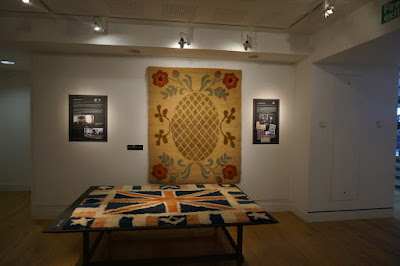The woven base (ground) in three natural colours
A taatit rug with geometric symbols
A box bed
The rugs were often made as wedding presents and would be used for the rest of their married lives. It was thought it give them protection from unwelcome guests such as trows that could take the soul of a woman during childbirth to look after one of their own babies.
A tattit rug given as a wedding gift to a couple in Houss, Burra Isle in 1871.
The pile would have made them very warm.
By the start of the 20th century the use of the rugs for bedcovers was overtaken by newer materials and the rugs became use more as decorative floor rugs like those shown in the photo below.
It was originally thought that taatit rugs were unique to
Shetland. You recently have found that a similar thing is also found in
Scandinavian countries. Can you tell me how you discovered that and a bit
about those rugs?
Taatit rugs are unique to
Shetland, but they are related to pile bedcovers that have been made across the
Nordic world and Ireland for centuries. I have known about rya rugs for a
long time – I remember when they were popular wall hangings in the 1960s!
I also knew that the way they are made is different from taatit
rugs. But what surprised me was how the designs in some of the Nordic
rugs are so similar to taatit rug designs. While it is possible that rug
designs developed independently, I now believe there was cultural contact and
exchange of rugs or rug designs between Shetlanders and Norwegians, Swedes and
Finns in the 18th century. The same thing happened in knitwear
design – it’s similar to colours and patterns seen across the Baltic, but at
the same time has a ‘Shetland’ look all its own.
Have you ever made a tattit rug yourself or do you ever
plan to?
I have not made a taatit rug,
and while it does interest me, I have a lot of other things that are higher on
my ‘to do’ list.
When you first started this project you had 34 samples in
the museum. I remember hearing a call on Radio Shetland for people to
come forward with any rugs they might have. Did you get a good response
to this?
I got an excellent response to
this, so much so that the project was extended a year and there are twice as
many rugs in the publication catalogue than previously envisioned.
I understand you are planning to produce a publication on
taatit rugs to follow the exhibition. Can you tell me any details about
this?
The publication will cover the
main themes of the research – how taatit rugs were made, their relationship to
Nordic rugs, their social importance as marriage rugs and heirlooms, taatit rug
design and motifs and their relationship with folklore, colour in rugs and the
use of natural dyes, and a chapter on taatit floor rugs. There will also
be a catalogue showing over 80 rugs and grounds with full-colour images.
Do you have to store the rugs in a particular way?
Yes, the rugs in our collection
are stored rolled. We get large cardboard tubes from carpet suppliers,
which we cover with foil and tissue to encase the nasty acids in
cardboard. Then the rugs are rolled around the tube with more acid-free
tissue and the whole thing is covered in an inert fabric and tied with fabric
tape. The rolls are labelled and suspended on a racking system.
Yes, but it is not one in our
collection. I fell in love with a rug owned privately because of the
amazing colour work in the design. Unusually, the colours are pastels –
yellows and corals. The maker had dyed natural colours like grey and fawn
to create additional shades. These were sewn next to white yarns dyed the
same colours to create subtle changes in colour throughout the rug. The
whole effect is rich, luxurious and very sophisticated – made in Yell in about
1870! If I were to make a rug, I would do so with these design principles
in mind.
Thank you Carol!
The exhibition runs until Sunday 19th July and is definitely worth a look. Carol will also be giving talks about the rugs in the museum on Friday 3rd July at 3.00pm and Sunday 12th July at 2.00pm.
I will keep you updated on when the publication is out!
Further reading:
CHRISTIANSEN, CAROL (2013). Taatit Rugs. Shetland Textiles 800 BC To The Present (Shetland Heritage Publications)




















